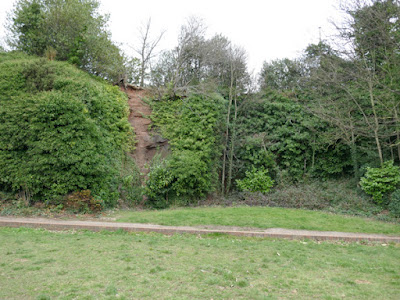 |
| Let's talk about the stones |
After my field trip to Whirlow and Ecclesall Woods with the Sheffield U3A Geology Group, following up my visit to the workshop of Steve Roche the previous month, I went with Janet Worrall of the Friends of Moorgate Cemetery to further discuss the possibility of having a sculpture made for Boston Park, using the Rotherham Red sandstone retained from excavtions for the new reservoir.
During this visit, Janet asked me if I was prepared to lead a couple of walks in April, which would involve a look at the geology of Boston Park and then the various memorials at Moorgate Cemetery. Knowing that most of the points of geological interest at Boston Park had largely disappeared, I went to have another look to see if a walk dedicated solely to the geology was viable and concluded that it wasn’t possible.
Instead, I suggested to Janet that we combine both on one day and concentrate on Moorgate Cemetery, where she had undertaken a considerable amount of research on the industrialists and other businessmen and notable Rotherham characters who are buried here – an event to which she gave the title “Let’s talk about the stones”.
Following on from my involvement with the Bolsterstone Graveyard Project and my visit to Moorgate Cemetery earlier in the month to photograph its Commonwealth War Graves Commission headstones and general memorials, it gave me a reason to look at the granites here in much greater depth.
With the walk aimed at members of the general public, which I presumed had little knowledge of geology, my plan was to introduce the attendees to sedimentary, igneous and metamorphic rocks and to look at the different granites from Scotland and the south-west of England and others from further afield – without going into great detail.
Using the Stroll in the Cemetery section of the Moorgate Cemetery website as my guide to the memorials, of which Janet had a much better knowledge than me and would be commenting on during the walk, the first memorial that I encountered was the very simple sandstone headstone of John Guest (d.1880).
As a partner of Guest and Chrimes, famous for its screw down taps and whose Grade II Listed foundry and brass works still survives in Rotherham despite a very suspicious fire, this is surprisingly modest for a person of his status.
His partner Richard Chrimes (d.1897) is commemorated with a more substantial hipped monument, which is made in a pale grey granite that has its slight foliation highlighted by black biotite mica, with a pink tinge to the feldspars. This looks like Ordovician Kemnay granite from Aberdeenshire, which was intruded approximately 475 million years ago (Ma).
Dr. Eric Robinson’s descriptions of this, in his London Illustrated Geological Walks, refer to an ‘oatmeal speckle’, but these books are illustrated with black and white photographs that aren’t very helpful. A much better resource to help with the identification of British granites is the British Geological Survey GeoScenic photo archive, where several samples show the variations in colour that might be expected in this granite.
My knowledge of Rotherham’s history isn’t very good and although I am aware of Sir Henry Bessemer, the inventor of the Bessemer steel making process, I know nothing about the firm Baker and Bessemer mentioned in the website and my next stop was to look at the memorials to various members of the Beatson and Beatson Clark families.
There are two massive sandstone memorials to various members of the Beatson family, who died between 1841 and 1854, but I am not sure if these had any connection to the firm Beatson Clark, which still operates as a manufacturer of glass bottles in central Rotherham - 270 years after the business was founded.
Clement (d.1925) and an Ernest Beatson Clark were connected to this business and the memorial is made of a very pale grey granite, with flecks of black biotite mica, but it lacks the pink tinge to the feldspars seen in Kemnay granite.
Although Aberdeenshire in the Grampian Highlands was the principal source of granites in
Scotland, with varied colours and textures, Devonian (c.400 Ma) ‘silver-grey’ granite was intruded into the Southern Uplands and was quarried at Dalbeattie and Creetown, with the latter having similarities to the granite used for the Beatson Clark memorial.













No comments:
Post a Comment